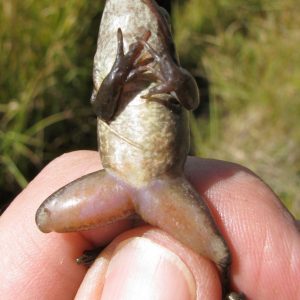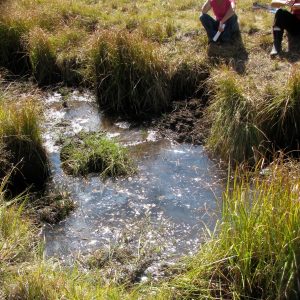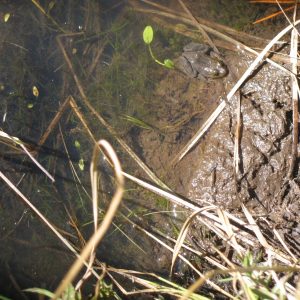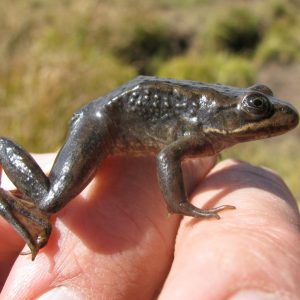As project lead on the Oregon Spotted Frog surveys, I was invited to come on a site visit in June 2013 to a historically important creek along with private landowners, US Forest Service staff and private consultants. The creek was Jack Creek, and frog populations here crashed from over 300 egg clusters each year to less than 30 within a few years. It is thought that the primary driver was an intense drought year combined with overgrazing. Since then, a number of measures have been implemented to try and remedy this severe population crash. Radio-tagged beavers were brought into the creek in the hopes that they would re-establish and build up ponds along the creek where old dams are deteriorating or are lost. Grazing intensity is being more carefully managed by USFS. The purpose of our visit was to review the habitat and determine what else could be done to restore the creek. A developing headcut along the creek is becoming more pronounced and moving up the creek bed, threatening to drain surrounding ephemeral wetlands and increase sediment transport via faster, straighter flows. The private consultants that were present on our field visit had a proposal to halt this development by filling the headcut in with sediments and allowing the stream to re-establish itself as a meandering creek. Their company had recently performed similar work at a Nature Conservancy property in the area, and initial results were promising. I asked them when it had been implemented and they said October of the year before.
The solution brought about some questions; what’s to stop the next seasonally high flow from washing the sediments out and undoing the restoration effort? Their previous work had not been implemented very long ago; what was the life expectancy of these projects? However, these concerns were not expressed by other members of the group. Perhaps it is because the system is primarily spring-fed and does not follow traditional flood trends. Perhaps it is because there is urgency to implement restoration now, before the frog gets listed as Threatened and even restoration projects on federal lands require a formal Biological Assessment. They spoke of spending a few days out there prior to restoration construction to catch whatever frogs they could and temporarily relocate them out of harms’ way.
So I spoke with the private landowner on our way back to our vehicles from the creek. The man owned land adjacent to the forest service land and he grazed his cattle along the creek on the USFS land. His opinion was that the land had been grazed for over a hundred years (by his ancestors) and that the frogs had been coexisting quite happily with the cattle in that time frame. Indeed in the absence of natural wildfires and presence of introduced plants, well-managed grazing can provide the disturbance the landscape needs to provide suitable habitat for Oregon Spotted Frogs (and other species). He thought we hadn’t really given the beavers the chance to do their part, and that the best approach would be to give the system time to work itself out. USFS and other public stakeholders are afraid that the frogs are running out of time, and more radical actions need to be taken. I’m not sure what the best approach is, I agree with both parties but I wonder about the impact of the proposed restoration effort.
We revisited the area on September 20th. We were looking for frogs in a newly colonized area where they had been seen 4 weeks previously by a member of the public who previously worked for the Forest Service. We found 3-4 subadults on a portion of USFS property adjacent to that same private landowners’ land, holding on in a very small pool that had been heavily impacted by cattle. Cows had been found in this particular land parcel previously and the landowner built a new fence to remedy the situation. So what now can be done? The biggest concern was water permanence; these particular pools exist along the largely dry creek bed, and seemed to be spring-fed by a seep adjacent to the channel. This seep had been heavily trampled. The biologists debated whether an artificial addition of water would be helpful or a waste of resources.
This whole experience brings up some very important questions in my mind. In a system that has been heavily altered, how much manipulation should be done to save an endangered species? When is it better to do something over nothing? The short-term plan is to contact the landowner about the cattle again and warn of potential loss of grazing rights. Plans are moving forward for the head cut restoration. The evidence of range expansion in the frogs at this site are a good sign, I just hope they are expanding into the right place.
CLM Internship Program Blog
Adventures of a CLM Intern




